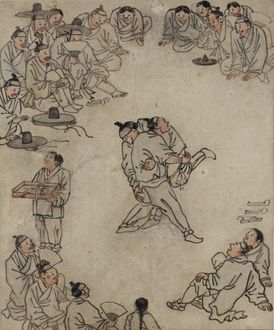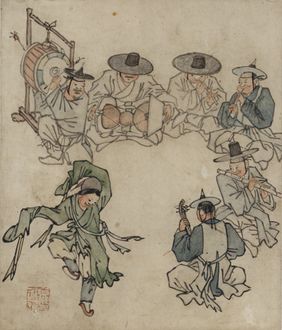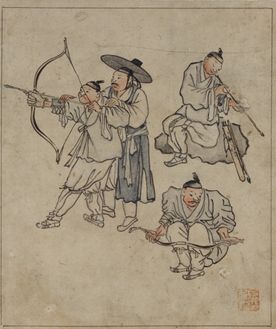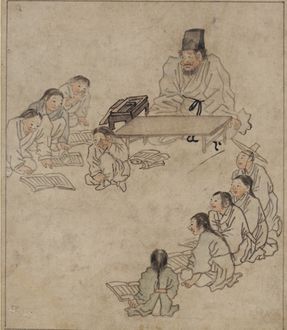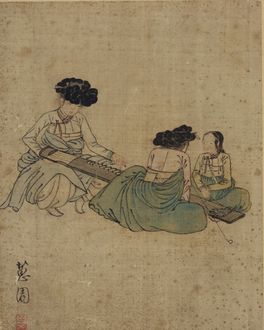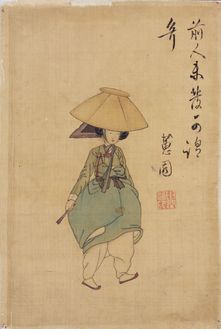"Document, Depict, Honor, and Express - Traditional Korean Painting"의 두 판 사이의 차이
| 10번째 줄: | 10번째 줄: | ||
Koreans initially depicted Chinese or artist-imagined landscapes in their landscape paintings, but began in the 18th century to depict real Korean scenic sites in what is called true-view landscape painting. This trend was led by the prolific painter [[Jeong Seon]]. Around the same time, genre paintings such as those by [[Kim Hong-do and Sin Yun-bok]] gained popularity. They depicted the everyday life of Koreans and are considered the most uniquely Korean genre of painting. Folk art – produced by mainly unknown, amateur artists – was used by commoners to ward off evil spirits or bring good fortune, particularly for events such as wedding ceremonies and shaman rituals. Common motifs include shaman or Taoist dieties, animals, and plants. | Koreans initially depicted Chinese or artist-imagined landscapes in their landscape paintings, but began in the 18th century to depict real Korean scenic sites in what is called true-view landscape painting. This trend was led by the prolific painter [[Jeong Seon]]. Around the same time, genre paintings such as those by [[Kim Hong-do and Sin Yun-bok]] gained popularity. They depicted the everyday life of Koreans and are considered the most uniquely Korean genre of painting. Folk art – produced by mainly unknown, amateur artists – was used by commoners to ward off evil spirits or bring good fortune, particularly for events such as wedding ceremonies and shaman rituals. Common motifs include shaman or Taoist dieties, animals, and plants. | ||
| − | Due to the Japanese invasions of 1592 and 1598, many paintings from before the 17th century have been lost. | + | Due to the Japanese invasions of 1592 and 1598, many paintings from before the 17th century have been lost. However many remain at public and private museums in Korea and abroad. |
| + | |||
<gallery mode=packed heights=220px> | <gallery mode=packed heights=220px> | ||
| + | File:NMK_김홍도_단원풍속도첩_씨름.jpg|Kim Hong-do - "Ssireum" / Courtesy of the National Museum of Korea (Gonggongnuri) | ||
| + | File:NMK_김홍도_단원풍속도첩_춤추는아이.jpg|Kim Hong-do - "Dancing Child" / Courtesy of the National Museum of Korea (Gonggongnuri) | ||
| + | File:NMK_김홍도_단원풍속도첩_활쏘기.jpg|Kim Hong-do - "Arrow Shooting"/ Courtesy of the National Museum of Korea (Gonggongnuri) | ||
| + | File:NMK_김홍도_단원풍속도첩_서당.jpg|Kim Hong-do - "Local Village School" / Courtesy of the National Museum of Korea (Gonggongnuri) | ||
| + | File:NMK_신윤복_거문고줄고르는여인.jpg|Sin Yun-bok - "A Woman Changing Geomungo Strings" / Courtesy of the National Museum of Korea (Gonggongnuri) | ||
| + | File:NMK_신윤복_대쾌도.jpg|Sin Yun-bok - "Daekwedo" / Courtesy of the National Museum of Korea (Gonggongnuri) | ||
| + | File:NMK_신윤복_전모를쓴여인.jpg|Sin Yun-bok - "A Woman Wearing a Jeonmo" / Courtesy of the National Museum of Korea (Gonggongnuri) | ||
| + | File:NMK_정선_신묘년풍악도첩_금강산.jpg|Jeong Seon - "Geumgangsan Mountain" / Courtesy of the National Museum of Korea (Gonggongnuri) | ||
| + | File:CHA_윤두서_자화상.jpg|Yun Du-seo's self-portrait / Courtesy of the Cultural Heritage Administration (Gonggongnuri) | ||
| + | File:NMK_김득신_정조의현륭원행차.jpg|King Jeongjo's procession to Hyeonnyungwon Tomb / Courtesy of the National Museum of Korea (Gonggongnuri) | ||
</gallery> | </gallery> | ||
2017년 11월 26일 (일) 08:30 판
Korea’s painting tradition dates back to the early Goguryeo period. Goguryeo tomb murals, along with those of Baekje and Silla, give insight into the fashion, society, and spiritual beliefs of ancient Koreans. After Buddhism was introduced to the Three Kingdoms, Buddhist paintings began to be produced. Such paintings flourished during the Unified Silla and Goryeo periods. Goryeo Buddhist paintings were highly regarded in Japan, and Korean artists were commissioned to produce Buddhist scrolls and murals which are extant in Japan today. Elaborate painted designs on Buddhist temple and royal palace buildings, called dancheong, were already in widespread use by the Goryeo dynasty. In the Joseon period, we can see a diversification of genres. Joseon period paintings include landscape paintings, portraits, genre painting, folk painting, documentary painting, and more.
Painting was seen as a way to document nature, events, people, and everyday life, depict stories to educate the people, honor deities and bring good fortune, and express one’s self artistically. By the Joseon dynasty, painting and calligraphy were seen as basic skills in which every royal and literatus must be proficient. However, there were also professional court painters as well as amateur artists among the commoner class.
Portraits, which depict kings, meritorious subjects, literati, and Buddhist monks, were often commissioned by the government. Self-portraits, such as that by Yun Du-seo, were also produced. The Joseon court visually recorded a wide variety of rituals and celebrations in the form of documentary paintings, which were used both as a reference for future events and a commemoration. Examples of these can be found in the Uigwe.
Koreans initially depicted Chinese or artist-imagined landscapes in their landscape paintings, but began in the 18th century to depict real Korean scenic sites in what is called true-view landscape painting. This trend was led by the prolific painter Jeong Seon. Around the same time, genre paintings such as those by Kim Hong-do and Sin Yun-bok gained popularity. They depicted the everyday life of Koreans and are considered the most uniquely Korean genre of painting. Folk art – produced by mainly unknown, amateur artists – was used by commoners to ward off evil spirits or bring good fortune, particularly for events such as wedding ceremonies and shaman rituals. Common motifs include shaman or Taoist dieties, animals, and plants.
Due to the Japanese invasions of 1592 and 1598, many paintings from before the 17th century have been lost. However many remain at public and private museums in Korea and abroad.
Related Articles
References
- Academy of Korean Studies. 2010. Cultural Landscapes of Korea. Academy of Korean Studies Press.
- Korea Foundation. 2010. Traditional Painting: Window on the Korean Mind Korea Essentials No. 2. Seoul Selection.
- Lee, Soyoung. 2004. Based on original work by Hwi-Joon Ahn. “Mountain and Water: Korean Landscape Painting, 1400–1800.” In Heilbrunn Timeline of Art History. New York: The Metropolitan Museum of Art, 2000–. http://www.metmuseum.org/toah/hd/mowa/hd_mowa.
- Lee, Soyoung. 2010. “Art of the Korean Renaissance, 1400–1600.” In Heilbrunn Timeline of Art History. New York: The Metropolitan Museum of Art, 2000–. http://www.metmuseum.org/toah/hd/kore/hd_kore.htm
